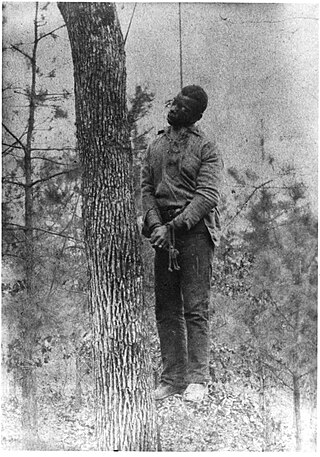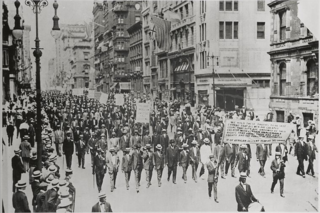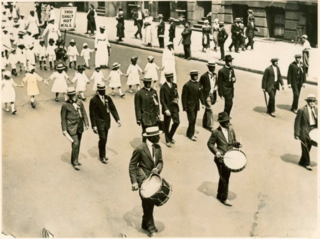
Walter Francis White was an American civil rights activist who led the National Association for the Advancement of Colored People (NAACP) for a quarter of a century, 1929–1955, after joining the organization as an investigator in 1918. He directed a broad program of legal challenges to racial segregation and disfranchisement. He was also a journalist, novelist, and essayist. He graduated in 1916 from Atlanta University.

Aaron Douglas was an American painter, illustrator and visual arts educator. He was a major figure in the Harlem Renaissance. He developed his art career painting murals and creating illustrations that addressed social issues around race and segregation in the United States by utilizing African-centric imagery. Douglas set the stage for young, African-American artists to enter the public-arts realm through his involvement with the Harlem Artists Guild. In 1944, he concluded his art career by founding the Art Department at Fisk University in Nashville, Tennessee. He taught visual art classes at Fisk until his retirement in 1966. Douglas is known as a prominent leader in modern African-American art whose work influenced artists for years to come.

Edward Prentiss Costigan was a Democratic Party politician who represented Colorado in the United States Senate from 1931 to 1937. He was a founding member of the Progressive Party in Colorado in 1912.

Lynching was the widespread occurrence of extrajudicial killings which began in the United States' pre–Civil War South in the 1830s and ended during the civil rights movement in the 1950s and 1960s. Although the victims of lynchings were members of various ethnicities, after roughly 4 million enslaved African Americans were emancipated, they became the primary targets of white Southerners. Lynchings in the U.S. reached their height from the 1890s to the 1920s, and they primarily victimised ethnic minorities. Most of the lynchings occurred in the American South, as the majority of African Americans lived there, but racially motivated lynchings also occurred in the Midwest and border states.

Jesse Washington was a seventeen-year-old African American farmhand who was lynched in the county seat of Waco, Texas, on May 15, 1916, in what became a well-known example of racist lynching. Washington was convicted of raping and murdering Lucy Fryer, the wife of his white employer in rural Robinson, Texas. He was chained by his neck and dragged out of the county court by observers. He was then paraded through the street, all while being stabbed and beaten, before being held down and castrated. He was then lynched in front of Waco's city hall.

"New Negro" is a term popularized during the Harlem Renaissance implying a more outspoken advocacy of dignity and a refusal to submit quietly to the practices and laws of Jim Crow racial segregation. The term "New Negro" was made popular by Alain LeRoy Locke in his anthology The New Negro.
The American Artists' Congress (AAC) was an organization founded in February 1936 as part of the popular front of the Communist Party USA as a vehicle for uniting graphic artists in projects helping to combat the spread of fascism. During World War II the organization was merged into the Artists' Council for Victory, which effectively spelled the end of the organization.

Prentiss Taylor was an American illustrator, lithographer, and painter. Born in Washington D.C., Taylor began his art studies at the Corcoran Gallery of Art, followed by painting classes under Charles Hawthorne in Provincetown, Massachusetts, and training at the Art Students League in New York City. In 1931, Taylor began studying lithography at the League. He became a member of one of the most important printmaking societies in America at that time, the Society of American Graphic Artists. Taylor interacted and collaborated with many writers and musicians in his time in New York in the late 1920s and early 30s. This was in the emergence of the Harlem Renaissance. Among his close friends and colleagues were Langston Hughes and Carl Van Vechten.

Laura and L. D. Nelson were an African-American mother and son who were lynched on May 25, 1911, near Okemah, Okfuskee County, Oklahoma. They had been seized from their cells in the Okemah county jail the night before by a group of up to 40 white men, reportedly including Charley Guthrie, father of the folk singer Woody Guthrie. The Associated Press reported that Laura was raped. She and L. D. were then hanged from a bridge over the North Canadian River. According to one source, Laura had a baby with her who survived the attack.

The Negro Silent Protest Parade, commonly known as the Silent Parade, was a silent march of about 10,000 African Americans along Fifth Avenue starting at 57th Street in New York City on July 28, 1917. The event was organized by the NAACP, church, and community leaders to protest violence directed towards African Americans, such as recent lynchings in Waco and Memphis. The parade was precipitated by the East St. Louis riots in May and July 1917 where at least 40 black people were killed by white mobs, in part touched off by a labor dispute where blacks were used for strike breaking.

The anti-lynching movement was an organized political movement in the United States that aimed to eradicate the practice of lynching. Lynching was used as a tool to repress African Americans. The anti-lynching movement reached its height between the 1890s and 1930s. The first recorded lynching in the United States was in 1835 in St. Louis, when an accused killer of a deputy sheriff was captured while being taken to jail. The black man named Macintosh was chained to a tree and burned to death. The movement was composed mainly of African Americans who tried to persuade politicians to put an end to the practice, but after the failure of this strategy, they pushed for anti-lynching legislation. African-American women helped in the formation of the movement, and a large part of the movement was composed of women's organizations.
Riva Helfond was an American artist and printmaker best known for her social realist studies of working people's lives.

Allan Randall Freelon Sr., a native of Philadelphia, US, was an African American artist, educator and civil rights activist. He is best known as an African American Impressionist-style painter during the time of the Harlem Renaissance and as the first African American to be appointed art supervisor of the Philadelphia School District.

A flag bearing the words "A man was lynched yesterday" was flown from the national headquarters of the National Association for the Advancement of Colored People (NAACP) between 1936 and 1938 to mark lynchings of black people in the United States. It was part of a decades-long anti-lynching campaign by the NAACP that began after the 1916 lynching of Jesse Washington. The flag was first flown after the lynching of A. L. McCamy in Dalton, Georgia, in 1936, and was stopped from flying in 1938 after the NAACP's landlord threatened them with eviction if they continued the practice.
Herbert Jacob Seligmann was an American author and journalist known for his writings on civil rights issues, African Americans, bigotry, the U.S. occupation of Haiti, and the rise of Nazism in Europe. He also wrote about well known artists such as Georgia O'Keeffe and John Marin, and about writers like D. H. Lawrence, Albert R. Brand, and J. Hendrix McLane. His review of Lady Chatterley's Lover appeared in The New York Sun but was removed from later editions because of the obscenity ban. His book on Lawrence was the first by an American. Seligmann was the first publicity director for the NAACP between 1919 and 1932, and was interviewed about the group's history on WNYC's radio program for African American subject matter. He also worked for the Jewish Telegraph Agency.
The lynching of Henry Lowry, on January 26, 1921, was the murder of an African-American man, Henry Lowry, by a mob of white vigilantes in Arkansas. Lowry, a tenant farmer, had been on the run after a deadly shootout at the house of planter O. T. Craig on Christmas Day of 1920. Lowry went into hiding in El Paso, Texas; when he was discovered and extradited by train, a group of armed white men boarded the train in Sardis, Mississippi, and took Lowry to Nodena, near Wilson, Arkansas. He was doused in gasoline and burned alive before a mob of 500. A reporter from the Memphis Press witnessed the event, and word of the lynching soon spread around the country, aided by an article William Pickens wrote for The Nation, in which he described eastern Arkansas as "the American Congo".

The Law Is Too Slow is a 1923 lithograph by American artist George Bellows (1882-1925), depicting the victim of a racist lynching. Originally commissioned to illustrate an anti-lynching story by Mary Johnston, the image came to be used by publications and organizations including the NAACP to advocate against lynching, and for federal anti-lynching legislation.
This Is Her First Lynching is a 1934 anti-lynching cartoon by American artist Reginald Marsh. It shows a white crowd attending a lynching; a woman in the crowd has a young child on her shoulders, and says to her neighbor, "This is her first lynching". The cartoon was shown in one of two 1935 New York anti-lynching exhibitions that aimed to support anti-lynching legislation. Scholars regard it as showing a young white girl's initiation in a communal process of racist violence.
Death is a statue by Isamu Noguchi, depicting a dead body of a person who had been lynched, inspired by the 1930 lynching of George Hughes in Texas. The almost life-sized statue was exhibited at one of two 1935 New York anti-lynching exhibitions, where its bad and overtly racist reception caused its creator to change career direction.
Aaron Goodelman was an American sculptor. He graduated from art school in Odessa, fleeing Eastern Europe for the United States in 1904 because of antisemitic violence.. He attended a number of major art schools in New York and Paris, and at the outbreak of World War I returned to New York and became a sculptor there. He joined the Communist Party, and took part in an important exhibition denouncing the lynching of African Americans. Following World War II, he began to make art related to the Holocaust, and taught art at CUNY.